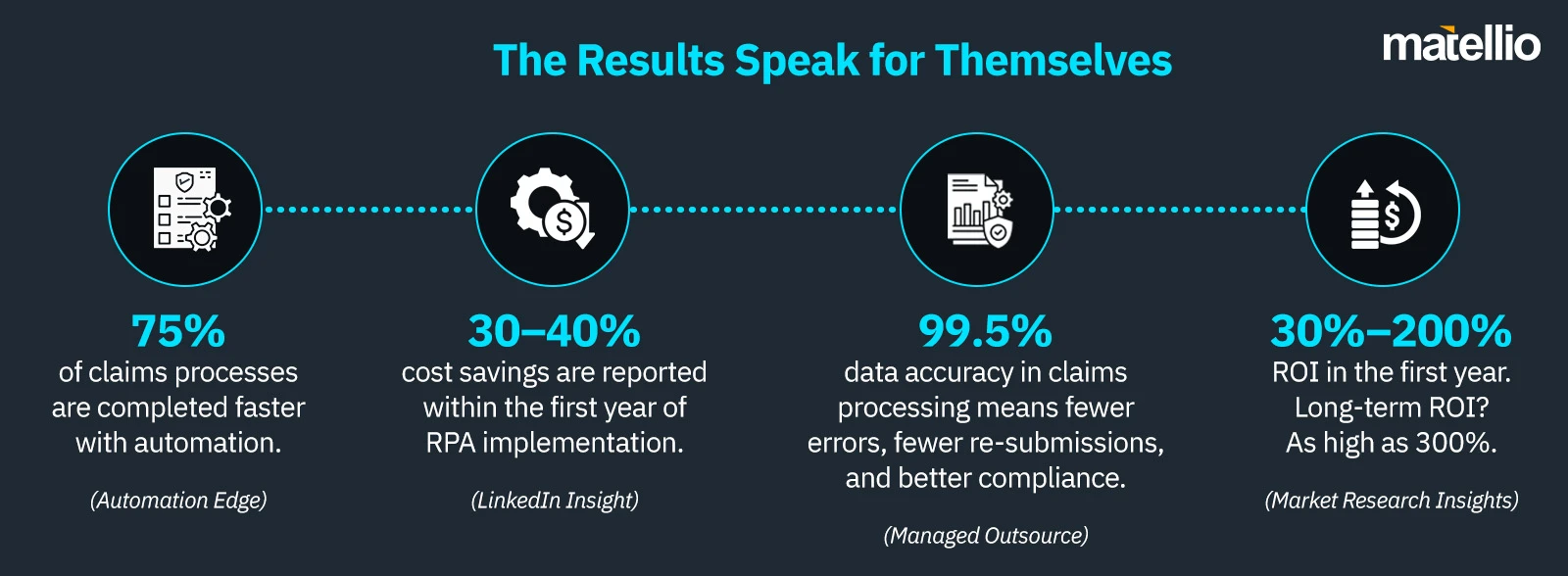
Every insurance company has the same challenge—too many manual tasks, too little time. Whether it’s handling claims, updating policies, or managing underwriting workflows, the daily process is full of repetitive work that eats into your team’s time and slows down customer service. That’s where RPA in the insurance sector comes in.
According to Allied Market Research, the global RPA in insurance market was valued at $98.6 million in 2021 and is projected to reach $1.2 billion by 2031, growing at a CAGR of 28.3% from 2022 to 2031.
Robotic Process Automation (RPA) uses bots to automate repetitive tasks like data entry, policy updates, and claims validation. When paired with AI integration services, these bots can also analyze large amounts of data, flag exceptions, and trigger faster decision-making.
Instead of juggling forms and back-end systems all day, your team can focus on high-value work like customer support, fraud detection, and product development.
Across the industry, we’re seeing real impact from RPA implementation in insurance—from faster insurance workflow automation to reduced processing errors and lower costs. It’s not just about saving time. It’s about scaling smarter.
Let’s take a closer look at how RPA in the insurance sector is changing the game.
How RPA in Insurance Sector Is Solving Real Problems
Let’s take a closer look at where RPA in insurance is actually working—and why it matters to your business.
Faster Claims Registration and Processing
Claims are detail-heavy. They often involve paperwork from multiple sources and take time to validate. That delays response times and frustrates policyholders.
RPA in the insurance sector claims processing simplifies this by:
- Extracting data from emails, forms, and scanned documents
- Notifying claims handlers automatically
- Assigning tasks based on rules you set
With RPA and AI in insurance, bots can process standard claims end-to-end, flag complex ones for review, and help reduce settlement time.
Result: Faster payouts, fewer errors, and higher customer satisfaction.
Policy Administration and Servicing
Managing policies involves updating records, processing renewals, handling cancellations, and answering routine customer questions.
RPA in insurance industry helps by:
- Automatically syncing policyholder data across systems
- Powering chatbots for 24/7 support (policy status, due dates, payment confirmations)
- Sending alerts for renewals or compliance deadlines
For insurers dealing with high service volumes, this improves consistency and reduces pressure on your service team.
Result: Lower admin costs, better service experiences.
On-Demand Scalability
During open enrollment or post-disaster events, insurance operations spike. Hiring more people takes time—and money.
RPA bots scale fast. They can:
- Handle thousands of claims in parallel
- Be turned on/off based on volume
- Support short-term or long-term demand
Whether you’re in health, auto, or life insurance, automation can adjust to business cycles without adding headcount.
Result: Fast scaling with no infrastructure overhaul.
Smarter Underwriting and Pricing
Underwriting is data-intensive. Analysts must pull info from multiple systems to assess risk. That takes time and leaves room for manual errors.
With RPA implementation in insurance, you can:
- Collect and organize data from multiple sources
- Pre-fill underwriting forms based on existing rules
- Score policies based on risk models, then send them for approval
Pairing this with AI services adds another layer of insight, helping insurers price more competitively and reduce underwriting time.
Result: Faster, more accurate policy decisions.
Sales and Distribution Support
Sales teams need clean data and updated metrics to perform. But pulling reports, tracking quotes, and managing territories manually slows everything down.
RPA in the insurance sector helps sales by:
- Auto-generating sales dashboards
- Flagging top-performing products and sales agents
- Sending reminders or follow-ups to prospects
It’s a way to integrate insurance workflow automation into the revenue side of your business too—not just operations.
Result: Clearer forecasting, better data, and improved sales productivity.
Streamlined Policy Cancellations
Policy cancellations involve multiple checks: dates, terms, payment statuses, etc. Done manually, it’s slow and often inconsistent.
RPA in insurance automates this by:
- Validating eligibility
- Pulling policy and payment history
- Generating standardized communication for the client
You can handle more cancellations with fewer errors—and fewer complaints.
Result: Cleaner back-office work and smoother exits.
Regulatory Compliance (Without the Overhead)
Compliance involves strict tracking, regular audits, and lots of manual checks. It’s critical—but expensive.
RPA in the insurance sector reduces that burden by:
- Logging transactions and generating audit-ready reports
- Running daily checks for rule violations
- Flagging incomplete or inconsistent entries
According to studies, RPA can improve compliance productivity by up to 50% and drastically reduce human error.
Result: Better compliance, fewer fines, and reduced risk exposure.
Works with Your Existing Tech—No Big IT Changes Needed
Worried about disrupting your current systems? Don’t be.
One of the best parts of RPA in the insurance sector is that it’s non-invasive. Bots work on top of your existing tools—just like a human would—by mimicking clicks and keystrokes.
This means you can:
- Use RPA with legacy tools or modern cloud platforms
- Avoid costly platform replacements
- Integrate faster with fewer dependencies
Result: Smooth implementation, lower risk, and faster time-to-value.
Let’s Implement RPA in Your Business Today! Get Started with a Free 30-minute Consultation.
RPA in the Insurance Sector: Why the Industry Isn’t Waiting
For years, RPA was treated like future tech. Now it’s just smart business. Today, the real conversation is no longer about whether RPA in insurance works—it’s about how fast you’re adopting it compared to everyone else.
Here’s what the numbers say:
The Market Is Moving—Fast
The global RPA in insurance market is projected to grow from $162.39 million in 2023 to $934.37 million by 2030, at a CAGR of 28.4%. (Maximize Market Research)
That kind of growth doesn’t happen without results.
Most Insurance Leaders Are Already In
Over 55% of insurance organizations are using RPA right now—and many are scaling it across departments. From underwriting to claims, RPA is now a core part of digital transformation roadmaps.
This isn’t about theory. It’s already happening in real workflows.

If you’re still asking, “what is RPA in insurance?”—your competitors are already past that. They’re rolling out RPA implementation in insurance across claims, underwriting, and compliance while gaining speed, precision, and profits.
And it’s not just about automation. RPA and AI in insurance are creating smarter, more agile workflows—and customers are noticing.
The only question is: Are you going to lead with it, or play catch-up later? Schedule a free 30-minute consultation to get started with RPA today!
Why Choose Matellio for RPA Implementation?
If you’re serious about using RPA in the insurance sector to improve operations, you need a partner who gets both the technology and your industry.
That’s what we do at Matellio.
We don’t push platforms. We build solutions that fit your systems, workflows, and goals. Here’s how:
RPA Built for Insurance Workflows
We design RPA implementation in insurance around real tasks—claims, policy servicing, compliance, underwriting. No guesswork, no generic bots.
Integrated with What You Already Use
We handle complete RPA development services—so your bots work with your core platforms, CRMs, claims systems, or legacy apps. No need to rip and replace.
Real Results, Not Pilots
We’ve helped insurers cut claim handling time, improve accuracy, and scale without hiring more staff. That’s how we measure success.
Scalable, Secure, and Compliant
From RPA in health insurance to large commercial carriers, we build with scale in mind—backed by HIPAA-level data protection and audit-ready logs.
Support That Doesn’t Drop Off After Go-Live
We stay with you post-launch. System updates, workflow tweaks, change requests—we’re part of your team, not just your vendor.
Let’s Build It Together
You’ve seen how RPA in insurance is already reshaping the industry. Now’s the time to move. Matellio delivers smart, scalable RPA development services—tailored for your systems, your goals, and your timeline.


